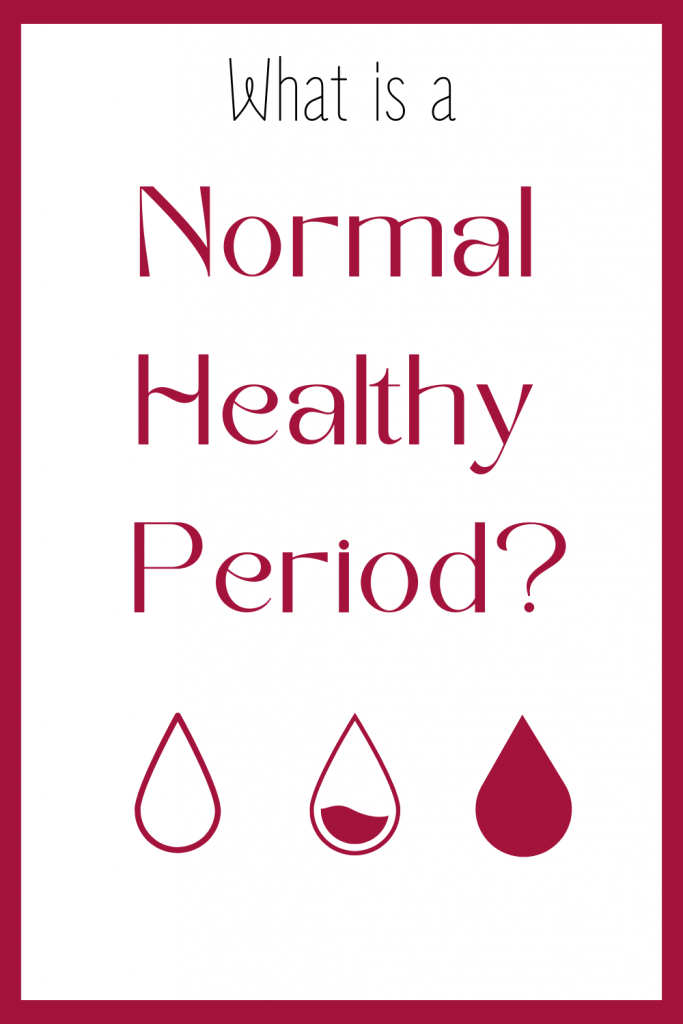
This article will guide you through the world of menstrual cycles and healthy periods. It’s time for all of us to understand what is a normal, healthy period and what’s not, and how to nurture our bodies for healthy and easy periods. Imagine a world where every menstruating person receives the support and healthcare they deserve – doesn’t that sound amazing?
As a naturopath with over a decade of experience, it never ceases to surprise me what women put up with every month. What’s more surprising is that most of you don’t even know that what you’re putting up with is NOT normal, it’s just what you’re used to. And, just because something is common, doesn’t make it healthy.
Let’s start with a quick recap because I want us all to be on the same page – no one left behind! So, before we dive into the 9 signs and symptoms of a healthy period, let’s cover some basics…
What is a period?
Your period is simply what happens when you bleed. In a healthy cycle, this occurs approximately every month. It’s a natural process that takes place because pregnancy didn’t happen during that cycle. The lining of the uterus, prepared by your hormones to nourish a fertilised egg, is shed as it is no longer needed.
Understanding the Menstrual Cycle:
This bleeding is part of your menstrual cycle, which is regulated by a series of hormonal events occurring from one period to the next. These events include the
- The period
- The follicular phase, leading to
- Ovulation, and then
- The luteal phase.
If pregnancy doesn’t occur, the uterine lining sheds, and the cycle begins again.
For a detailed explanation of the hormones and phases of your menstrual cycle, feel free to check out my previous article on Anatomy and Hormones of the Menstrual cycle.
The Significance of Ovulation:
While your period might be the most noticeable (and sometimes troublesome) event, the ultimate goal of each menstrual cycle is OVULATION. This is when the egg is released every month. In a healthy, regular cycle, ovulation occurs regularly, indicating balanced hormones and higher chances of pregnancy.
If you are unsure about your ovulation signs and symptoms, click here to read more.
Importance of a Healthy Menstrual Cycle:
Now, I get it – most of us spend a lot of our lives trying not to get pregnant. But here’s the thing: a healthy menstrual cycle and period are indicators of your overall health. They offer valuable insights into your hormonal balance and provide information about your future fertility.
If you ARE trying to conceive, having a normal and healthy period and menstrual cycle is even more crucial. Below, I’m going to walk you through the 9 signs and symptoms of a healthy menstrual cycle that you should track every cycle.
If you are NOT trying to conceive, keeping an eye on these signs and symptoms, we can identify any hormone imbalances, pinpoint possible causes, and work towards restoring your health and fertility. 🌸✨
Let’s dive in and explore the nine vital signs and symptoms you should track to ensure your period and menstrual cycle are healthy and balanced.
9 SIGNS AND SYMPTOMS OF A HEALTHY PERIOD AND BALANCED MENSTRUAL CYCLE
** Every sign and symptom is briefly outlined below, offering a glimpse into the intricacies of your menstrual health. For a deeper understanding, dedicated blogs delve into each aspect. Feel free to click through and explore the related articles for comprehensive insights. Happy reading! 📚✨**
1. Menstrual Cycle Length: A Vital Indicator
Teenagers: For our younger menstruators, a cycle lasting between 21 to 45 days is considered normal. Adolescence is a period of hormonal maturation, so irregularities are expected initially.
Adults: In adulthood, a healthy menstrual cycle ranges from 21 to 35 days, with the optimum range for hormone balance and fertility falls between 26 to 34 days. Shorter or longer cycles may indicate hormonal imbalances, requiring attention and care.
Therefore, A healthy menstrual cycle length for an adult is
- 21-35 days, or
- Aiming for 26-34 days when trying to conceive.
A menstrual cycle length that indicates hormone imbalances is one that is:
- Shorter than 21 days, or
- Longer than 35 days
Remember: Healthy menstrual cycles are a reflection of balanced hormones and future fertility as you can better predict ovulation.
**for a further delve into menstrual cycle length, discussing short cycles, long cycles and irregular cycles and what’s happening hormonally, read “Menstrual Cycle Length”
2. Actual Bleeding: Separating Full Flow from Spotting
A healthy period starts with full-flow bleeding. No Spotting.
Full flow is described as red blood and full flow should require you to wear a pad, tampon, menstrual cup or all the other beautiful options we have not.
Spotting, which occurs between cycles, or just before or after your period. Spotting is minimal blood loss, mostly consisting of droplets of blood that can be brownish or light pink in colour. This may be seen as you wipe with toilet paper or might mark your underwear, but wouldn’t necessarily leak through your underwear onto your clothes.
If you see spotting before your full-flow commences, mark this in your period app or calendar as spotting, not as Day 1 of your period.
Proper tracking helps differentiate spotting from the actual period, ensuring accurate understanding of your cycle. Spotting before full-flow period often indicates inadequate progesterone levels to sustain the lining of the uterus.
3. Duration of Blood Loss: Understanding the Ideal Length
Ideally, periods last 2 to 7 days. If you get your period on a Sunday, the following Sunday, your period should be completely finished.
So ideal, healthy flow is 2-7 days.
1-2 days of bleeding can be considered scanty and MIGHT cause difficulty in trying to conceive, but not always.
It is certainly not healthy or normal to be bleeding for more than 7 days. Prolonged bleeding might indicate issues such as hormonal imbalances or uterine lining problems. It’s essential to monitor and seek guidance if your period extends beyond the healthy timeframe.
4. Amount of Blood Loss: A Closer Look
The average blood loss over a menstrual period is around 50ml (approximately 2 tablespoons).
Too much or too little blood loss may indicate underlying concerns. If your blood loss is below 20ml, it is considered scanty and indicates lack of sufficient endometrial lining. If your blood loss is above 80ml, it is called menorrhagia, which is the medical word for heavy bleeding and considered abnormal uterine bleeding.
Monitoring the number of pads or tampons used provides valuable insight into your menstrual health. 1 regular size tampon or pad that is fully soaked will hold approximately 5mls of blood and 1 super tampon or pad that is fully soaked will hold approximately 10mls of blood. Therefore, record what size tampon or pad you use, how many you use during the day and how full each one is. Half full or fully soaked and calculate from there.
I give a great visual aid on my YOUTUBE video, click for the link.
Remember: Track your flow to identify what’s normal for you.
5. Consistency of Period Blood: Clues in Texture
Your period should be mostly liquid with small clots. Small, stringy clots are considered healthy and normal, but if you see clots larger than 2cm in diameter, it would be a good idea to seek out advice from your doctor, especially if accompanied by heavy bleeding.
6. Colour of Period Blood: A Sign of Health
Your period should be bright red at the start and the blood may darken towards the end of your bleed. Spotting before your period indicates insufficient hormone levels. Darker colour full-flow bleeds, black or tarry blood might indicate potential issues, stagnant blood or insufficient shedding of the uterine lining. Any unusual colours warrant a healthcare professional’s evaluation.
For more details on all things related to your period ‘your actual bleed’ read on here. And my article here “Your Period Guide to Normal Blood Loss”
7. Pain: Evaluating Discomfort
Period pain, though common, should be minimal and manageable. Excessive pain, especially if it interferes with your daily life, is a red flag. Tracking the type, intensity, and duration of pain provides valuable information for natural healthcare providers.
To assess your pain, rate it on a scale from 0 to 10.
Zero signifies no pain, while 10 implies pain persists despite medication, which absolutely warrants medical investigation.
Note the pain’s nature—sharp or dull—and its duration. Is it continuous, or does it come in spasmodic bursts?
More on Period Pain here
8. PMS Symptoms: Identifying Patterns
Premenstrual symptoms occurring within the 10 days leading to your period (and they should resolve within a day or two of your period) are common but shouldn’t disrupt your life. Tracking emotional and physical changes helps distinguish regular PMS from abnormal symptoms that might need attention.
Common emotional symptoms include increased irritability, snappiness, anger, sadness and even depression. And common physical symptoms include breast pain, fluid retention, sleep disruptions, headaches, food cravings and pimples.
Record all your PMS symptoms, track what days you experience the signs and symptoms and after tracking for a few menstrual cycles, it will be clear if they are PMS.
For all the pains of your period, read more here
9. Cervical Fluid: Nature’s Fertility Indicator
Often overlooked, cervical fluid (also known as vaginal mucous/ discharge or ovulation mucous) plays a vital role in your menstrual cycle. Monitoring its consistency – from sticky to creamy to watery to egg-white – provides insights into ovulation. Healthy cervical fluid indicates balanced hormones and optimal fertility.
Tracking and recording your cervical fluid from cycle to cycle can give us natural healthcare practitioners information about hormone balance, ovulation prediction and can help us assess your fertility and help improve your outcomes.
I’ve included this indicator for completeness, but this topic is so amazingly life-changing that it deserves its own blog all to itself, so to take a deeper dive into the 4-types of cervical Fluid and all that you need to know about this mysterious fluid, read here.
Conclusion: Empowerment Through Knowledge
Understanding your menstrual cycle is a powerful tool. By tracking these nine signs and symptoms diligently, you gain valuable insights into your reproductive health. I hope now that you can track 9 signs and symptoms of your period and menstrual cycle and fully understand what is a normal, healthy period. If any aspect seems unusual, seek the guidance of a skilled healthcare professional who listens and understands your concerns.
Remember, your body communicates its needs; it’s our job to listen and respond with care and knowledge.
Empowering you on your journey,
Amanda, Naturopath xx
